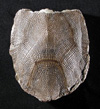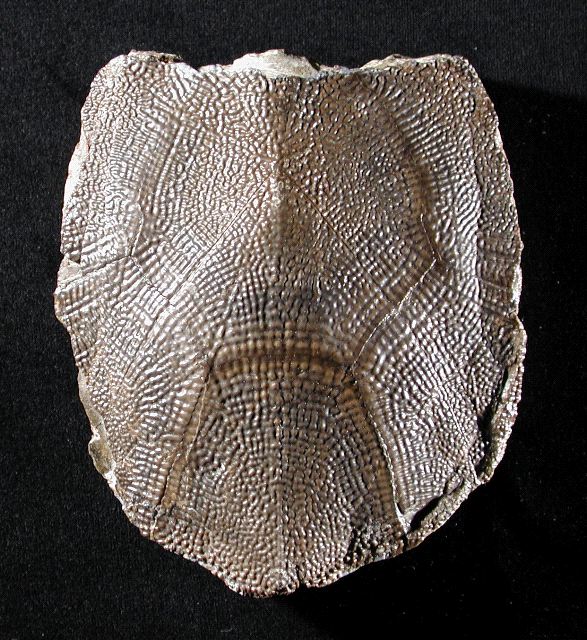Placoderms
Placoderms, mysterious prehistoric fish, were often mistaken for tortoises and other armoured animals in the 19th century.
 (120 kb) Placoderms were among the first animals with jaws but have no living representatives, a fact that led to a number of erroneous early interpretations based on their unusual forms. In general, placoderms are easily distinguished by their heavy armour made of large bony plates covering their head and thorax, and sometimes even their pectoral fins.
(120 kb) Placoderms were among the first animals with jaws but have no living representatives, a fact that led to a number of erroneous early interpretations based on their unusual forms. In general, placoderms are easily distinguished by their heavy armour made of large bony plates covering their head and thorax, and sometimes even their pectoral fins.
Placoderm armour was quite easily fossilized and is often all that remains of the animal, the tissue of their tail and fins being too delicate to preserve. The general absence of these non-armoured body parts helps explain the mistaken interpretations by paleontologists who studied the first placoderm specimens.
Even when correctly identified, these animals are still strange. Their dermal plates, for example, are not analogous to the skull bones of modern fish. In fact, they are not even similar between the different placoderm groups! A comparison with other fish, even with other placoderms, is therefore quite useless for understanding their anatomy. Their jaws and pectoral fins are also so unusual that they bear little resemblance to those of other gnathostomes.
Placoderms first appeared at the very beginning of the Silurian Period, but did not become common until the beginning of the Devonian. At this point they underwent an extraordinary adaptive radiation that allowed them conquer every aquatic ecological niche, taking on forms that ranged from large predators to small bottom-dwelling fish that fed on filtered sediment. Placoderms were only partially affected by the great mass extinction of the Upper Devonian, but suddenly disappeared at the Devonian-Carboniferous boundary without leaving any descendants.
Although equipped with solid bony plates on the outside, they had a cartilaginous internal skeleton like that of sharks, which explains the difficulty in finding well preserved non-armoured body parts. But when such parts are discovered, as is sometimes the case at Miguasha, it is possible to discern an epicercal tail with a main lobe pointing upwards, a single dorsal fin, and sometimes the attachment points for pelvic fins.
Specialists have identified five or six groups of placoderms worldwide, including more than 200 genera. For 50 million years, placoderms dominated the aquatic world of the Devonian, living in saltwater, brackish and freshwater bodies. It was only when they disappeared that sharks began to diversify, eventually becoming the great predators of the sea.
Two of the placoderm groups are present at Miguasha: antiarchs and arthrodires. True to form, the Escuminac Formation delivered exceptionally well preserved specimens in both cases.

 (120 kb) Placoderms were among the first animals with jaws but have no living representatives, a fact that led to a number of erroneous early interpretations based on their unusual forms. In general, placoderms are easily distinguished by their heavy armour made of large bony plates covering their head and thorax, and sometimes even their pectoral fins.
(120 kb) Placoderms were among the first animals with jaws but have no living representatives, a fact that led to a number of erroneous early interpretations based on their unusual forms. In general, placoderms are easily distinguished by their heavy armour made of large bony plates covering their head and thorax, and sometimes even their pectoral fins.Placoderm armour was quite easily fossilized and is often all that remains of the animal, the tissue of their tail and fins being too delicate to preserve. The general absence of these non-armoured body parts helps explain the mistaken interpretations by paleontologists who studied the first placoderm specimens.
Even when correctly identified, these animals are still strange. Their dermal plates, for example, are not analogous to the skull bones of modern fish. In fact, they are not even similar between the different placoderm groups! A comparison with other fish, even with other placoderms, is therefore quite useless for understanding their anatomy. Their jaws and pectoral fins are also so unusual that they bear little resemblance to those of other gnathostomes.
Placoderms first appeared at the very beginning of the Silurian Period, but did not become common until the beginning of the Devonian. At this point they underwent an extraordinary adaptive radiation that allowed them conquer every aquatic ecological niche, taking on forms that ranged from large predators to small bottom-dwelling fish that fed on filtered sediment. Placoderms were only partially affected by the great mass extinction of the Upper Devonian, but suddenly disappeared at the Devonian-Carboniferous boundary without leaving any descendants.
Although equipped with solid bony plates on the outside, they had a cartilaginous internal skeleton like that of sharks, which explains the difficulty in finding well preserved non-armoured body parts. But when such parts are discovered, as is sometimes the case at Miguasha, it is possible to discern an epicercal tail with a main lobe pointing upwards, a single dorsal fin, and sometimes the attachment points for pelvic fins.
Specialists have identified five or six groups of placoderms worldwide, including more than 200 genera. For 50 million years, placoderms dominated the aquatic world of the Devonian, living in saltwater, brackish and freshwater bodies. It was only when they disappeared that sharks began to diversify, eventually becoming the great predators of the sea.
Two of the placoderm groups are present at Miguasha: antiarchs and arthrodires. True to form, the Escuminac Formation delivered exceptionally well preserved specimens in both cases.
Site map | Feedback | Links | Sources | Credits
Placoderms
<< Jawed fish | Antiarchs >>



